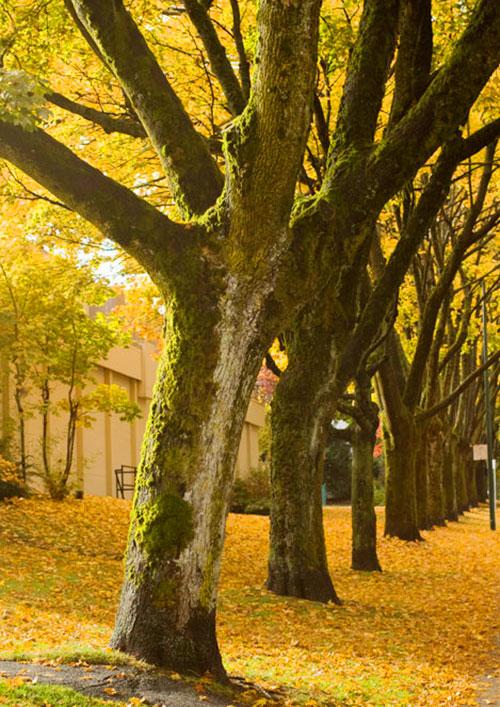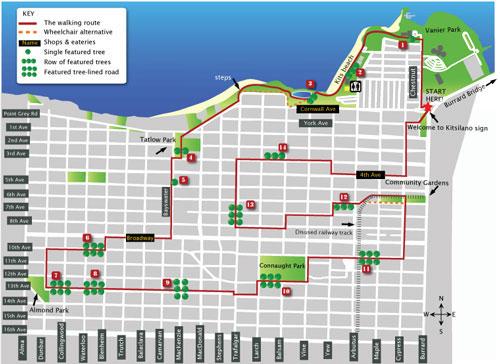
Vancouver’s Kitsilano neighbourhood is known for many things: Lululemon-clad women pushing strollers, vintage hippies, coveted real estate, and unrivalled waterfront, for example. But when Ryanne Matthias moved there in October of 2008 she was struck by another sight—trees. Beautiful, diverse, mature trees.
In an effort to share the wonder with others, Matthias developed the kitsTREEmap, a 12-kilometre circle route featuring 14 trees that takes at least three hours to complete. For those with more time to spare, Matthias, who encourages people to learn to identify their local trees as a way of connecting to the environment, recommends taking a full day, working in a visit to Kitsilano Beach in the morning, lunch along Broadway, dinner on 4th avenue, and a return to the waterfront for sunset.
While the trees may be showiest in spring, fall is another ideal time to explore the route, “with some of the normally green tree-lined streets turning bright yellows, oranges, purples, reds and pinks.” For more info and a free copy of the map go to kitstreemap.com

Q & A with Ryanne Matthias of KitsTREEmap
Q: What inspired you to create KitsTREEmap?
A: There were so many wonderful things about Kits–the artistry found in both residential and community gardens, the alternative, environmentally friendly sensibility, coastal location, mountainous backdrop, and of course the sheer density and number of street trees. It was all just so delightful and I attached very quickly. . . . I wanted to share what I was seeing and experiencing.
Tourists with limited time will visit downtown, they may also come to Kits and go to the beach and shopping streets, but there is so much more to see. Most significantly, the beautifully majestic trees and tree-lined avenues. So I planned a route using some of them as way-points so they could not be missed. As a plant enthusiast I took the opportunity to say a few descriptive and devotional things about these trees. I was helped and inspired by a book by the late Gerald Straley, a UBC academic.
Q: What makes the trees on the route significant?
A: I spent a long time working out a route that highlighted as many of the characteristic elements of Kitsilano as possible. I wanted it to show both the natural beauty (i.e. trees, gardens, green spaces) and its cultural verve. I knew I had to include 10th Avenue with the tulip trees, Kits Beach with the weeping willows, and the most lively blocks of 4th and Broadway. But there were other things to consider, too. It took ages to decide. It may seem to be a small website but a lot of thought, consideration, and time went into it. Kits is a large neighbourhood, and with so much to see, the walk may seem quite long for some people. But you would not believe how many tree-lined streets I was pained to leave out. I feel quite confident that a first-time visitor to Kitsilano will find that KitsTREEmap will show them a lovely mix of its best aspects.
Q: Which is your favourite tree on the route and why?
A: I have a particular attachment to the Japanese zelcova–the first tree on the walk. The proximity of the donut shaped tree with the triangular shape of the building creates a striking contrast when in full foliage.
Q: Which tree is most spectacular in the fall?
A: When I first arrived in Kitsilano it was the fall and I think this was key to me noticing right away that the trees here are something else. The colours were spectacularly kaleidoscopic, alight with every colour and tone you could imagine: yellows, oranges, reds, pinks and others in between. . . . The weather before and during will determine colour, and many different species contribute to it, but the maples that turn bright red are a constant.
Q: For the average tree lover, getting out of the city and into the forest would seem the best option—what is it about urban trees that’s special/different/important in your mind?
A: Urban trees are not a substitute for wild habitats. I don’t think it is an either/or scenario that if you have one you don’t need the other. Urban trees serve their own purpose for biodiversity and well-being. While being in the forests of B.C. is nothing short of magical, you will not see the range and variety of trees there that you can find in downtown Vancouver, both deciduous and evergreen species. If you’re interested in learning how to identify different species of trees, the streets of Vancouver are a great place to start. Just make sure you have a copy of Gerald Straley’s book and probably one other ID book with pictures and a key.
Urban trees and community gardens were just one part of the botanical impact Vancouver had on me. The mountains introduced me to alpine plants too, which became a bit of an obsession, so much so that at the end of three years I decided to go back to England to do a master’s degree in botany. After finishing my degree I started working for my professor on a biodiversity project called the Catalogue of Life. For part of that role I write a blog, and a number of my posts have been inspired by B.C. species of plants and animals.
During my time in Vancouver I attended events put-on by the Native Plant Society, Nature Vancouver, Van Dusen and UBC botanical gardens. I gained a considerable amount of free learning through the generosity of others who were willing to share their knowledge. These groups are a fantastic tribute to Vancouver. They allowed me to get informed about the local environment and natural history. KitsTREEmap was my attempt to give something back.

